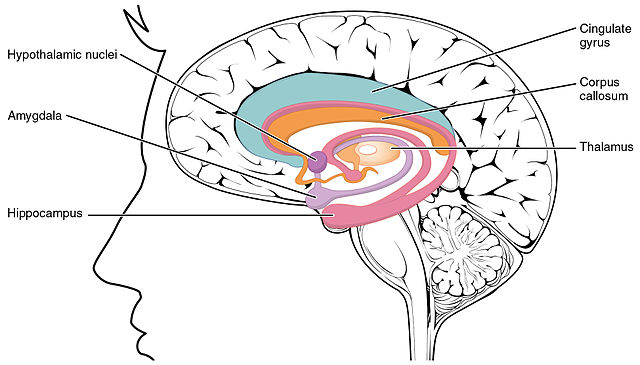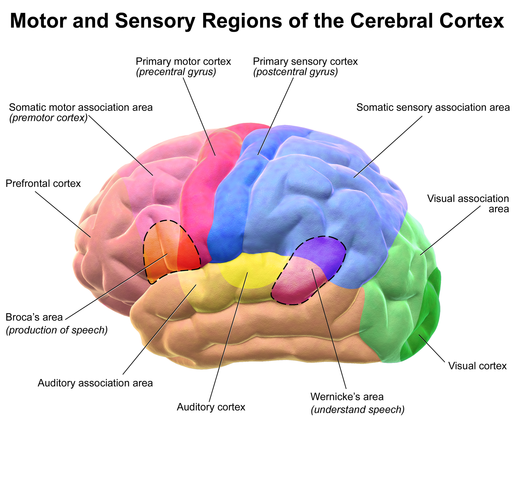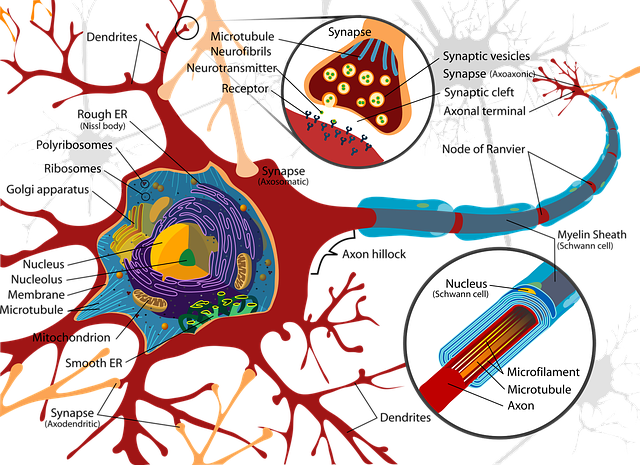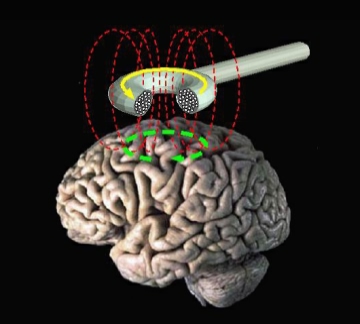Intelligence is the resource that allows us to take advantage of all other resources around us. And the augmentation of the human brain is probably the most radical method to vastly enhance our abilities and significantly improve our lives.
Contents
Brain structure
The brain is a part of the central nervous system. Different locations of the brain have specific functions.
Roughly speaking, in terms of evolutionary scale, there are three major parts in the brain.
The oldest part of the brain consists of the brainstem and some other structures. The brainstem is in charge of many absolutely necessary functions of the body, such as heart beating and breathing. This structure is extremely important for maintaining life. But it’s not directly involved in high mental activities.
A more evolutionary recent part of the brain represents the limbic system. There are several structures with different functions in the limbic system, but the main function of this system involves processing various emotions.

Some studies have shown that some patients with the structures of the limbic system having been damaged can’t make even very simple everyday choices. It turns out that in order to make any decision we should not only think but also feel. Not only are emotions involved in decision-making, it turns out that they are also extremely important for memorization. We are more likely to memorize the information that provokes a deep emotional response. Apparently, that’s how we’re wired.
The newest part of the brain is the cerebral cortex, which lies above all other brain structures. This layer is only 2 to 4 mm thick. In higher mammals, especially in humans, the cerebral cortex is intensely folded. The more convolutions, the greater the surface area. So, the larger the number of nerve cells the cortex can contain.
The cerebral cortex is the region of the brain that is mostly responsible for our cognitive capabilities. A majority of researchers in the field of human brain augmentation are paying much closer attention not to the subcortical regions but to the cortex in order to find clues for radical brain enhancement.
The cerebral cortex has a horizontal and vertical organization. The horizontal organization is characterized by six layers.
Neurons – nerve cells – within some layers send signals to other areas of the neural cortex or subcortical structures of the brain. Whereas, neurons of the other layers receive signals from different areas of the neural cortex or other brain regions.
The vertical organization of the cerebral cortex represents 3 million cortical columns. Within each cortical column, all the neurons are interconnected with each other. Every column is connected to approximately 1000 other columns.
Within each cortical column, there are about 50-100 minicolumns. Each minicolumn comprises about 100 neurons and has a specific function. For example, a single cortical minicolumn in the visual area of the brain recognizes only a very specific visual stimulus, whereas, in the primary auditory cortex, each minicolumn recognizes only a very specific frequency of sound.
Different areas of the cerebral cortex perform different functions. But if certain areas have been damaged, other areas can, to some extent, replace the functions of the damaged areas. The principles of information processing in all regions of the cortex are identical.

Prefrontal section of the cerebral cortex is crucial for higher mental functions such as reasoning or planning, and it is most developed in humans compared to other mammals.
Neurons
The major cell type in the brain, as well as in the whole nervous system, is a neuron. Each typical neuron cell consists of a cell body, axon, and multiple dendrites. Usually, the axon has numerous branches which connect to dendrites of other neurons forming myriads of junctions called synapses.

On average, the human brain has about 100 billion neurons interlinked to each other by approximately 100 trillion synapses, comprising a gigantic neuron network. The structure of synaptic connections between neurons is influenced by both genes and experience, and this structure largely determines our mentality.
The number of neurons in the adult brain does not change very much during a lifespan until severe neurodegenerative processes start to take over under some circumstances. However, neurogenesis – the birth of new neurons – also continues throughout entire life, but it is a relatively small amount of neurons. It has been shown in some studies on animals that the process of neurogenesis in the brain is more vigorous if the animals are located in a new environment and they actively learn something new.
In most cases, signals in neurons are sent from an axon of one neuron to a dendrite of another, but there are many exceptions to this rule. For example, there are neurons that lack dendrites and others that lack axons.
The neuron is quite a long cell. The neural signal or the action potential, which is basically a flow of electrically-charged ions, moves along the axon to the synapses. When the impulse of ions arrives at the synapse, a pre-synaptic neuron can release special molecules called neurotransmitters. These signaling molecules travel across synaptic cleft and bind to the receptors of a post-synaptic neuron. This process is called neurotransmission.
There are many types of neurotransmitters, both excitatory and inhibitory. Some neurotransmitters can be either excitatory or inhibitory, depending on the type of receptors they bind to. Different neurons release different neurotransmitters. The postsynaptic neuron may receive excitatory and inhibitory inputs from many neurons at the same time. These influences are summed up in some sense in the postsynaptic neuron. If the net effect is inhibitory, the neuron will be less likely to transcend the signal to the next neurons and if the net effect is excitatory, the neuron will be more likely to transcend the signal.
Naturally, the speed of signals between neurons is substantially slower than, for instances, the speed of electrons in metals. A neuron can be fired up about only 200 times a second, and yet a transistor in modern processors does it several billion times, which is several million times faster.
In addition to neurons, the nervous system contains other types of cells – glial cells. These cells also perform essential functions. For example, the major function of some glial cells is axon myelination – an electrical insulation of axons, without which electric impulses along axons would be propagating even slower.
Brain performance

The brain consumes a considerable amount of energy of the body – around 20% – and constantly requires oxygen and glucose. If oxygen or glucose uptake to the brain is temporarily constrained, neurons very soon start to act incorrectly and disintegrate, so the person dies in a few minutes.
The brain has a remarkable plasticity – as we learn, our brains change: certain synapses are getting strengthened, which at a molecular level means that more neurotransmitters bind to receptors in those synapses. Also, new synapses are being formed and some old synapses are being lost all the time, especially when we learn. In general, these mechanisms are called a synaptic plasticity.
Reinforcement of synapses or formation of new ones between neurons is quite similar to learning in modern artificial neural networks. There are also profound distinctions, however.
The basic unit of logic in the brain is not a neuron cell. Molecules such as neurotransmitters, receptors, and maybe some others represent the smallest logic units in the brain.
Most likely, we can specify the complete number of basic logic units in the brain as the total number of receptor/neurotransmitter pairs in all synapses of the brain. Different studies show the different numbers of receptors in different types of synapses. (http://www.jneurosci.org/content/jneuro/27/8/2135.full.pdf). If we assume that the average number of receptors in a single synapse equals 100, then the total number of these receptors in the brain must be around 100 × 100 hundred trillion, which is 1019. This is a staggering number.
Does it mean that we should have a computer with about 1019 logic units to be able to simulate the brain effectively? It seems to be not necessary because the information processing in the brain is significantly slower than in electronic computers.
Strategies for human brain augmentation
There are several different possible strategies for dramatic improvement of the brain: neuroenhancers or neurological drugs, nanotechnology, connection to additional neural tissues, brain-computer interfaces, neural stimulation by applying specific magnetic fields, stem cells, gene therapy.
Neuroenhancers
Apparently, there are numerous neurological processes that can be influenced by various pharmaceutical interventions. For example, it was shown that a certain mutation of a specific receptor in dendrites could decrease the ability to forget, thus increasing the ability to remember. Although this mutation is not beneficial (the ability to forget unnecessary or harmful to our psychology information is vital – there has to be a balance between forgetting and remembering), in principle, we may use a specific chemical that temporally blocks this receptor, so we can increase our learning capabilities when we need it. This is a possible example of using drugs to enhance memorization and learning. Other examples can also be adduced.
Reportedly, there are already several drugs on the market, such as modafinil, methylphenidate (MPH), and memantine that can be used as neuroenhancers.
The brain is protected by the blood-brain barrier from potentially dangerous substances and particles that may be circulating in the blood system in some situations. Only relatively small molecules can penetrate through this natural barrier, and in many cases, it impairs delivering drugs to the brain.
Medical nanotechnologies
Medical nanotechnologies have many amazing benefits. Combining drugs with neuro-nanotechnology is a very promising approach in augmentation of brain functions. (To read more about that: http://www.ncbi.nlm.nih.gov/pmc/articles/PMC4064704/). For example, using nanoparticles can enable crossing the blood-brain barrier, so drugs can be delivered to the brain. Furthermore, this method allows us precise delivering drugs in specific areas of the brain.
Connection to external neural networks
There is an idea shared by many futurologists that we can significantly extend our cortical cortex by connecting it with external artificial or biological neural networks. However, under more careful examination, the situation doesn’t look very optimistic, at least in the near future.
For my humble point of view, this has several very significant technical challenges. First of all, as we’ve shown earlier, the cortical cortex has a very fine structure, where the neurons within the cortical cortex are interconnected with one another and neurons of other regions of the central nervous system. So, in order to truly enlarge a natural cortical cortex, we should extensively, probably each mini-column, interconnect it with an external cortical cortex. In addition, creating an elaborate artificial cortical cortex is beyond our modern technical capabilities.
Brain-machine interfaces
Also, there is an opinion that if we directly connected the brain to digital computers, we would expand natural intelligence tremendously by harnessing the advantages of electronic computing – much higher speed, bigger memory capacity (both temporal and permanent), more accurate storage of data.
Similarly to using additional biological neural networks, in the case of plugging digital computers into the brain in order to enhance cognitive capabilities, we will most likely have to connect most of our cortical columns to electronic components, which also seems absolutely inconceivable, at least in the coming years.
It seems very unlikely that we’ll soon be able to vastly improve our cognitive capabilities using brain-computer interfaces. However, such interfaces will be extremely important and very common in our everyday life for the other task. This task is feeding computers with instructions directly, by sheer thought. For example, it can be manipulation of electronic devices by simply thinking.
Moreover, to do this, we don’t necessary need to connect computers with brains physically. A living brain is constantly broadcasting radio waves. These signals are exceedingly faint, and seemingly cannot be perceived and decoded by other brains. But special equipment can decipher these impulses and convert them into meaningful machine instructions. For example, sensitive fMRI (functional magnetic resonance imaging) machines can detect faint radio-wave signals emitted from the brain, allowing us to trace the flow of thoughts in the brain.
Such brain-machine interfaces based on radio waves will be a big game changer in the near future and alter the way we communicate with machines and, supposedly, even with people. We will be able to be connected mentally with computers controlling any conceivable machines.
We will control computers directly with our minds, and we will be in mental contact with digital assistants that will silently carry out our wishes.
Recently, Elon Musk has launched a new company called Neuralink, a venture to merge the human brain with AI, they say. They coined a new term “neural lace” for their device currently under development which will supposedly connect the brain with a computer. So, we’ll see.
Stimulation by magnetic fields

We know that synapses can be strengthened when the neurons that form them are fired. When a neuron is fired, some amount of electrical charge flows through it. If we apply a specific magnetic field to some area of the brain, electrical charges may occur in the neurons of this area. So, in principle, we can provoke neural activity by applying specific magnetic fields to the brain. It can be used, for example, to pass information directly into the brain. For instance, by using transcranial magnetic stimulation (TMS), one can selectively silence or stimulate various regions of the brain. Presumably, by doing so, people can temporally acquire miraculous mental skills like savant-like. Also, downloading memories and therefore new skills and knowledge into the brain seems possible and only a matter of time.
Presumably, by doing so, people can temporally acquire miraculous mental skills like savant-like. Also, downloading memories and therefore new skills and knowledge into the brain seems possible and only a matter of time.
Stem cells
Using stem cells is another alternative that scientists can use to increase cognitive functions. Stem cells are such cells that can differentiate into any type of specialized cells in the body including neurons. All regenerative medicine is largely based on different applications of stem cells.
Nerve cells cannot divide, so it had been thought for a long time that a total number of neurons in the brain can only decrease over time of a life span. However, it has been shown that stem cells regularly emerge in the brain, and a certain number of new neurons do emerge during life. In the adult human brain, stem cells can naturally form only in two regions (https://www.ncbi.nlm.nih.gov/pmc/articles/PMC3106107/). These stem cells give rise to the formation of only two very specific types of neurons. In most natural cases, they cannot form nerve cells in the cerebral cortex. However, we can use certain procedures to turn these natural stem cells into neurons of the cortex.
In addition to natural stem cells, external stem cells can be placed in the brain. It seems very promising to use external stem cells to cure a damaged brain, especially when we deal with such neural disorders like Alzheimer’s disease. Furthermore, stem cells could be used to create new neurons in special regions of the brain. Perhaps, we can inject additional stem cells in certain locations of the brain in order to vastly increase our specific mental skills. However, it has been shown that using external stem cells in the brain is not safe. It can provoke the formation of cancer in a brain tissue. So, these techniques remain to be improved.
Gene therapy
It is known that intelligence is a heritable trait, determined by many genes. It has been shown that additive effects between genes are greater than epistatic (combinatorial) ones in determining this trait. This means that significant increase of intelligence can be achieved by combining more appropriate genetic elements in one genotype.
Although there are serious ethical considerations associated with changing genomes of human beings that have not even been born yet, it’s possible to pick out embryos with preferable combinations of genes. Pre-implanting genetic screening is already in practical use. However, using only selection has its limitations. By combining selection with genetic engineering, more prominent results can be achieved.
Gene editing or therapy is a very promising field, which continues to develop very rapidly. Scientists have recently developed new promising methods in this area, for instance, CRISPR gene editing. Obviously, the progress in this field will continue.
Genetic code can be changed before a birth, or during a life span of a person (somatic gene therapy). Using somatic gene therapy for the enhancement of cognitive capacities of an adult brain has its drawbacks. The main point is that the brain largely forms during very early phases of body development. In more later phases, the brain cannot be substantially augmented by means of modern gene therapy.
On the contrary, if the genome is changed before the brain formation, it seems very realistic to improve intelligence (as well as other important traits). It’s possible that, for example, undesirable sequences of DNA be removed from the genome prior fecundation or right after the formation of a zygote (a cell formed as a result of fertilization that gives rise to the embryo), so the whole genome in every single cell of the body will be changed.
The desired transmission of a mitochondrial genome of a human zygote has been already obtained, and this technology is already in use in medical practice. However, the technologies that would enable precise controlling the formation of the whole nuclear genome will not likely emerge very soon. Moreover, the role of many elements in the nuclear genome is still not entirely clear, as well as epigenetic factors, some of which are apparently inherited and substantially contribute to the formation of various phenotypic traits, including intelligence.
Instead, altering individual genes is more realistic than the whole genome interventions.
As we said, intelligence is determined by many genes, but certain specific genes play more prominent roles in its regulation. There are many studies reviling many such genes influencing mental processes. For example, it has been shown that the gene HAR1 is at least partially responsible for the convolution of the cerebral cortex, and presumably, some modifications of this gene can yield more intensive folding of the cerebral cortex so that the number of neurons in the brain becomes larger.
At the cellular level of neurons, there are also other prominent targets which can be used to increase intelligence by genetic modifications. For instance, overexpression of the NR2B subunit of the N-methyl-D-aspartate neuroreceptor has led to improving the formation of new memories in transgenic mice in several studies.
Also, researchers have already developed certain techniques for therapy of brain illnesses by methods of gene therapy. Probably many of these techniques will soon be used in conventional medicine, first of all for the neural disorders that are caused by single genes like Huntington disease.
Obviously, gene therapy seems a very powerful method to increase cognitive capabilities. On the other hand, we don’t know to what extent we can increase human intelligence with the help of gene therapy. Potential augmentation of intelligence is limited by the capabilities of the human body. As we said, brain cells must constantly receive oxygen and glucose, which are supplied with blood. And we cannot vastly increase the supply of these resources to the brain. Probably, there are many other strong restrictions to increasing intelligence by gene therapy.
Awesome! Thanks for this post